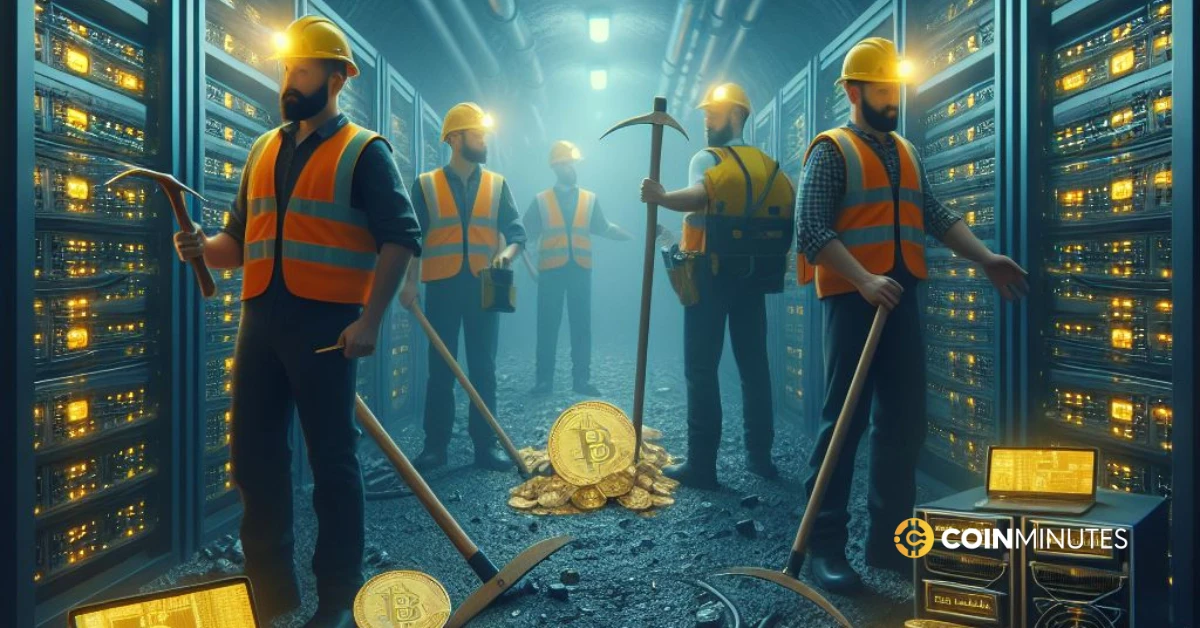Bitcoin mining is how Bitcoin operates and is created. It is as important and indispensable as the engine in a car. So what is Bitcoin mining? Let’s find out in this article by CoinMinutes.
Key Takeaways
|
What Is Bitcoin Mining?
Bitcoin (BTC) mining is the process of using computers to solve complex mathematical problems to confirm and process transactions on the Bitcoin network. When these problems are solved, participants (miners) are rewarded with Bitcoin.
How Does Bitcoin Mining Work?
Initially, miners collect and confirm transactions from the Bitcoin network’s mempool, which holds unconfirmed transactions. These transactions are then organized into a new block.
Before a block can be added to the blockchain, miners must solve a computational puzzle known as Proof of Work (PoW). This step involves finding a specific nonce (a number) that when combined with the block data and hashed, results in a hash that meets the network’s difficulty target. Miners use specialized hardware to test many nonce values until they find the correct one.
When a miner solves the puzzle, a new block is added to the blockchain, and the miner receives newly created Bitcoins and transaction fees as a reward. This process continues with miners competing to process transactions and secure the Bitcoin network.
Read more: How Bitcoin Mining Works
To gain a deeper understanding of Bitcoin mining, it is essential to comprehend some related concepts.
Proof of Work (PoW)
Proof of Work (PoW) is a method used to add new blocks of transactions to a cryptocurrency’s blockchain. In this process, the “work” involves generating a hash (a long string of characters) that matches the target hash for the current block. The cryptocurrency miner who accomplishes this task earns the right to add that block to the blockchain and receive rewards.
Mining Hardware: ASIC and GPU
ASIC (Application-Specific Integrated Circuit) and GPU (Graphics Processing Unit) are both types of hardware used in cryptocurrency mining, particularly for mining Bitcoin and other cryptocurrencies. Here’s a comparison of these two technologies.
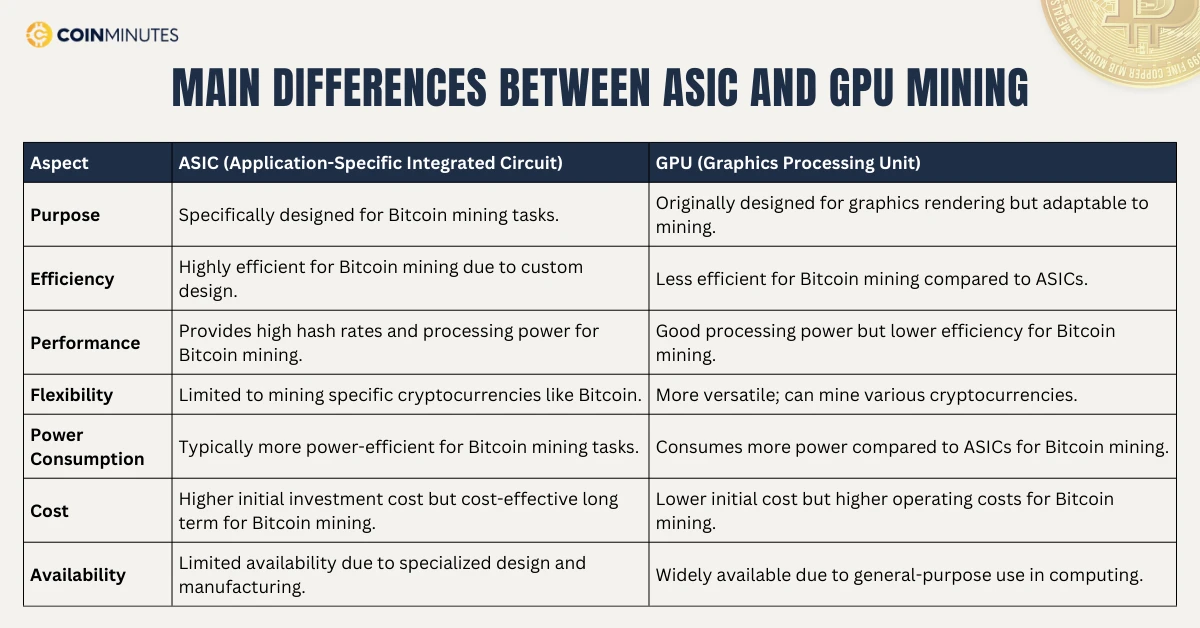
Mining Software
Mining software is a program installed on computers or specialized devices to facilitate the process of cryptocurrency mining. The primary functions of mining software include:
- Solving computations (hashes): Mining software solves hash computations to discover solutions for new blocks on the blockchain. This involves competition among miners to find blocks and earn rewards.
- Submitting transactions and receiving new blocks: Once a solution for a block is found, mining software submits new transactions and block information to the blockchain network for verification and storage.
Some popular mining software include CGMiner, BFGMiner, and EasyMiner. These programs support various mining devices and offer different features to optimize mining operations.
Mining Pools (Mining Groups)
Mining Pools also known as a mining group, is a collective of miners combining their mining power to increase the likelihood of finding blocks and receiving rewards. Instead of operating independently, miners in a mining pool work together to share the workload and rewards after discovering a block.
Key characteristics of mining pools include:
- Reward Distribution: When a mining pool finds a block, the reward is distributed proportionally among the members based on their contributions.
- Increased Block Discovery Opportunity: By pooling mining resources from multiple miners, a mining pool enhances the chances of finding blocks and earning rewards compared to solo mining.
- Mining Operations Management: Mining pools provide a management interface to monitor the mining activities of individual miners within the pool.
Popular mining pools like Slush Pool, AntPool, and F2Pool offer reliable mining services to cryptocurrency miners.
Block Rewards & Transaction Fees
Miners are incentivized by block rewards and transaction fees to secure the network and validate transactions. Let’s explore the differences between them.
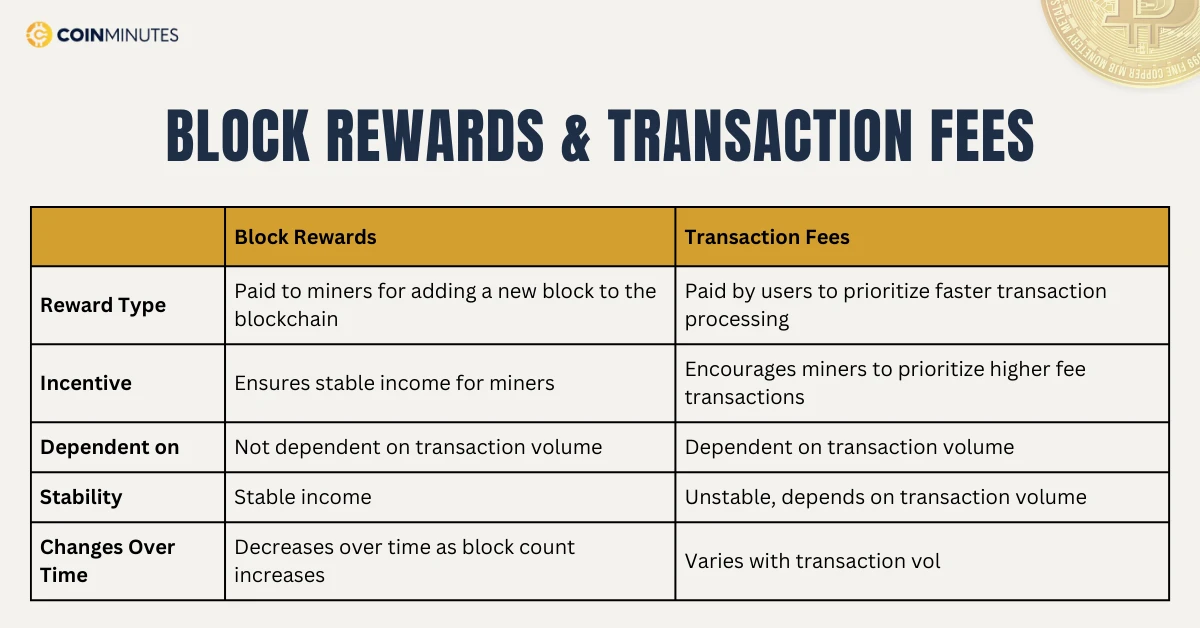
Why Is Mining Bitcoin Important?
Mining Bitcoin plays a crucial role in maintaining the security of the Bitcoin network and preventing issues like double-spending, ensuring consensus among network participants.
Maintaining the Security of the Bitcoin Network
Bitcoin mining is more than just creating new currency—it is a critical foundation for maintaining the security and fairness of the Bitcoin network. This process is central to building a decentralized, trustworthy financial system.
- Anti-Fraud Measures: Due to the complexity of the computational puzzles, altering data in a confirmed block is highly challenging. This reduces the risk of fraud and transaction history tampering.
- Decentralization: The involvement of networked computers in transaction verification ensures fairness and decentralization. There is no single central authority controlling the process.
- High Reliability: The Bitcoin network automatically adjusts the difficulty of mining puzzles to maintain a 10-minute interval between new blocks being added to the blockchain. This helps prevent attacks such as the 51% attack.
Revents Double-spending and Ensures Consensus among Participants
The mining process in the Bitcoin network not only prevents double-spending but also ensures consensus among participants. When a transaction is initiated and sent, nodes in the Bitcoin network collectively participate in the transaction verification process through mining. Nodes compete with each other to solve a complex mathematical problem, and the successful node creates a new block containing the confirmed transactions.
This process not only verifies the validity of transactions but also prevents tampering by allowing only specific transactions to be recorded in each block. Consequently, every confirmed transaction requires consensus from the entire network, enhancing the security and reliability of the system.
Evolution of Bitcoin Mining
The evolution of Bitcoin mining equipment from CPUs to ASICs and Cloud mining represents a progressive and innovative journey in the cryptocurrency industry. Here is an overview of these stages:
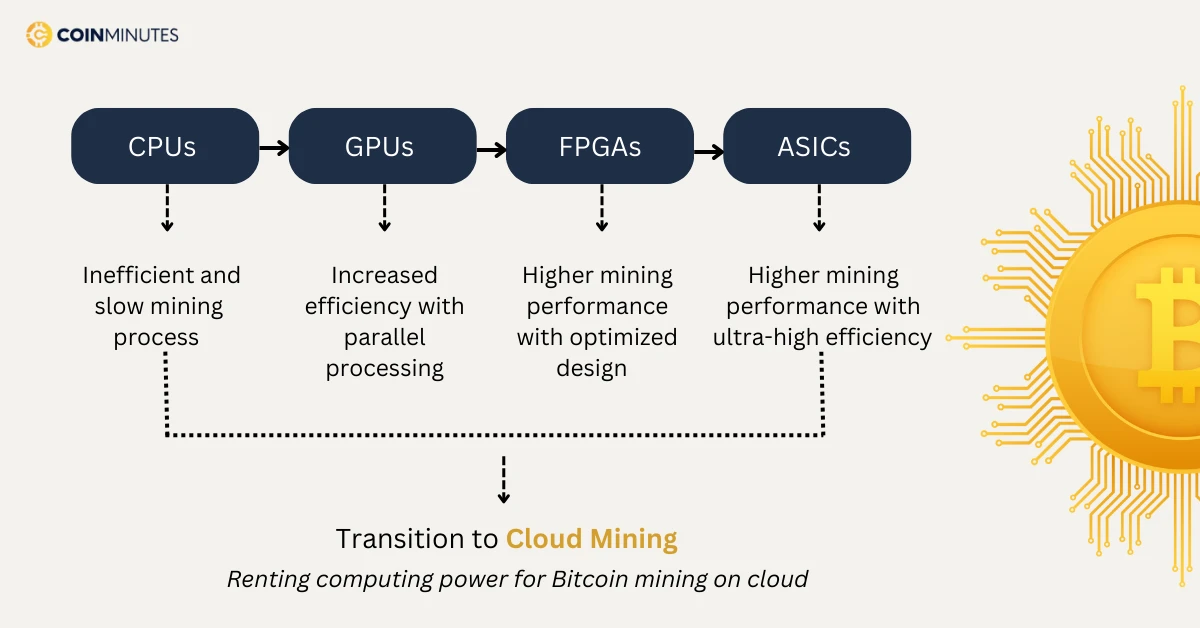
CPUs (Central Processing Units)
Initially, when Bitcoin was introduced in 2009, mining could be done using regular CPUs on personal computers. However, due to the nature of the mining algorithm (SHA-256) and the increasing transaction volume, CPU mining became slow and inefficient.
GPUs (Graphics Processing Units)
Subsequently, miners transitioned to using GPUs during this phase. GPUs offer better parallel processing capabilities compared to CPUs, significantly increasing Bitcoin mining efficiency.
FPGAs (Field-Programmable Gate Arrays)
FPGAs represented a significant advancement in Bitcoin mining technology. They could be programmed to perform functions more efficiently than GPUs. Although not as specialized as ASICs, FPGAs played a crucial role in accelerating the process.
ASICs (Application-Specific Integrated Circuits)
This marks the final stage of the upgrade process. ASICs are specially designed chips that perform functions with extremely high efficiency and low power consumption. Miners shifted to using ASICs to optimize performance and investment costs.
Cloud Mining
Finally, a recent trend is the use of cloud mining services. Instead of purchasing and operating individual mining devices, users can rent computing power from cloud mining centers to participate in the Bitcoin network. Cloud mining reduces the need for initial capital investment and enhances convenience.
Bitcoin Mining Cost
The costs associated with this involve several expenses. Below are two key costs involved in Bitcoin mining:
- Hardware Costs: To mine Bitcoin effectively, specialized mining hardware known as miners is required. The cost of purchasing these devices can be a significant initial investment.
- Electricity Costs: Bitcoin mining operations consume a substantial amount of electricity. Mining rigs operate continuously to solve complex mathematical problems, thus demanding a large amount of electrical energy. Electricity costs can be one of the largest expenses in the mining process.
In addition, there are other costs associated with Bitcoin mining such as maintenance, cooling, network, software, and service costs, etc.
Read more: Is Bitcoin mining profitable?
Bitcoin Mining Issues
Bitcoin mining consumes a lot of electricity so it has encountered a lot of controversy and limitations.
Legal Issues
Bitcoin mining operations can face legal challenges in certain countries due to cryptocurrency regulations, tax evasion concerns, and potential illegal mining practices involving unauthorized electricity sources or non-compliant equipment.
Environmental Issues
Bitcoin mining faces criticism due to its high energy demands, greenhouse gas emissions, and extensive hardware requirements. Cryptocurrencies also contribute to emissions throughout their production and disposal phases, generating significant e-waste.
Bitcoin’s global electricity consumption of 173.42 TWh from 2020 to 2021 exceeds that of some countries, according to a study published by the journal Earth’s Future. For example, that amount of power exceeds the combined electricity consumption of Argentina and the Philippines.
Mining Alternatives
Proof of Stake (PoS) and Proof of Capacity (PoC) are two alternative methods to Proof of Work (PoW) in the process of mining cryptocurrencies like Bitcoin. They provide different approaches to validating transactions and securing the network without requiring intensive computational power like PoW.
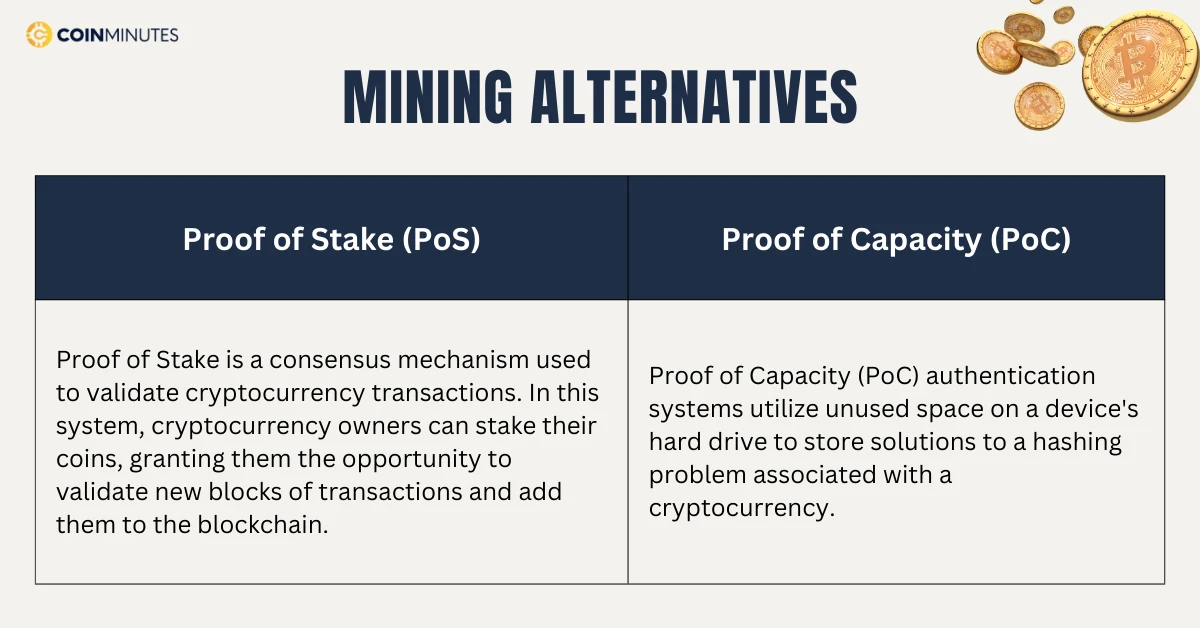
The Bottom Line
An overview of Bitcoin mining provides a deep insight into how the Bitcoin network operates and its crucial role in building a decentralized and trustworthy financial system. Understanding this process not only benefits cryptocurrency investors but also serves as the first step to participate in and contribute to the global cryptocurrency revolution.

